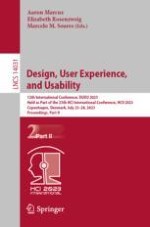This 5-volume HCII-DUXU 2023 book set constitutes the refereed proceedings of the 12th International Conference on Design, User Experience, and Usability, DUXU 2023, held as part of the 24th International Conference, HCI International 2023, which took place in Copenhagen, Denmark, in July 2023.
A total of 1578 papers and 396 posters have been accepted for publication in the HCII 2023 proceedings from a total of 7472 submissions.
The papers included in this volume set were organized in topical sections as follows:
Part I: Design methods, tools and practices; emotional and persuasive design;
Part II: Design case studies; and creativity and design education;
Part III: Evaluation methods and techniques; and usability, user experience and technology acceptance studies;
Part IV: Designing learning experiences; and chatbots, conversational agents and robots: design and user experience;
Part V: DUXU for cultural heritage; and DUXU for health and wellbeing.
